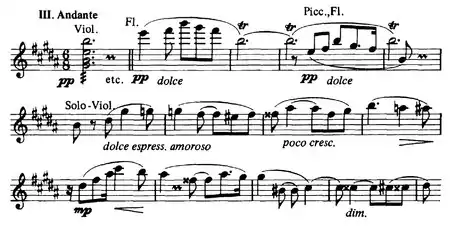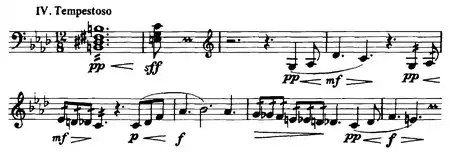Alexander Scriabin's Symphony No. 2, Op. 29, in C minor was written in 1901 and first performed in St Petersburg under Anatol Lyadov on 12 January 1902.
Structure
The second symphony is the most structurally conventional of all Scriabin's symphonies.[1] However, it features extensive thematic transformation establishing a cyclic link between its movements. The sombre initial theme of the first movement is developed to a triumphant hymn functioning as the main subject of the finale.[2]
The symphony consists of five movements, although the first two and the final two are connected to each other without a break:
- Andante (C minor)
- Allegro (E flat major)
- Andante (B major)
- Tempestoso (F minor)
- Maestoso (C major)
Reception
When Vassily Safonoff first conducted Scriabin's Second Symphony (which he did in Moscow sometime between 1902 and 1903), he waved the score at the orchestra and said, "Here is the new Bible, gentlemen..."[3]
References
- ↑ Bernard Jacobson: Scriabin, Symphonies 1, 2 and 3, etc., 1991, UPC 724356772021.
- ↑ Wendelin Bitzan: Taneev, Skryabin, and the Orchestra: Concepts of Thematic Unity in Russian Symphonies at the Turn of the 20th Century, in: Journal of the Russian Society for Music Theory, No. 13 (2016), p. 5f.
- ↑ Aspen no. 2, item 2: Scriabin Again and Again
External links




